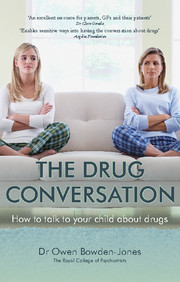Book contents
- Frontmatter
- Contents
- Acknowledgements
- Introduction
- 1 What are psychoactive drugs, who uses them and why?
- 2 Drug use and adolescence
- 3 Having the drug conversation with your child
- 4 Drugs and the brain
- 5 Types of drugs
- 6 Rise of the synthetics
- 7 Detecting drug use and what to do about it
- 8 Treatment and recovery
- 9 Final thoughts
- Appendix
- References
- Index
6 - Rise of the synthetics
Published online by Cambridge University Press: 01 January 2018
- Frontmatter
- Contents
- Acknowledgements
- Introduction
- 1 What are psychoactive drugs, who uses them and why?
- 2 Drug use and adolescence
- 3 Having the drug conversation with your child
- 4 Drugs and the brain
- 5 Types of drugs
- 6 Rise of the synthetics
- 7 Detecting drug use and what to do about it
- 8 Treatment and recovery
- 9 Final thoughts
- Appendix
- References
- Index
Summary
Legal highs, club drugs, research chemicals and novel psychoactive substances
The past 40 years has seen the manufacture of a large number of synthetic drugs intended for recreational use. Labelled variously designer drugs, legal highs, club drugs, research chemicals and novel psychoactive substances, they have two things in common. First, they attempt to mimic the effects of ‘traditional’ drugs, such as cocaine and cannabis. Second, they are produced specifically for recreational purposes, with no intention on the part of the manufacturers to give any medical benefits. They are, essentially, drugs for fun.
Some of these synthetic drugs were developed by pharmaceutical companies, but discarded because their psychoactive effects were too powerful or other side-effects were considered too severe. In other cases, new synthetic psychoactive drugs are manufactured by modifying the chemical structure of existing drugs, in an attempt to make new and more powerful versions. For example, amphetamine, a stimulant drug, has been chemically modified to produce hundreds of similar drugs.
New synthetic drugs have been developed to mimic all the psychoactive drug effects a user could wish for, including synthetic stimulants, synthetic sedatives, synthetic hallucinogens and synthetic cannabis. There has never been a wider choice of drugs available to users. Many of these new variations fall outside existing drug control legislation and because of this are technically legal.
The rise of the synthetics
The past decade in particular has seen an extraordinary rise in the production and distribution of synthetic psychoactive drugs. Globally, 95 countries or territories have detected 541 new psychoactive substances since 2008 (United Nations Office on Drugs and Crime, 2013). There has been a huge increase in the number of new substances available for sale on European drug markets. Since 2008, that number has increased every year, with 101 new substances detected in 2014 alone (European Monitoring Centre for Drugs and Drug Addiction, 2015; Fig. 6.1).
One of the problems with the new synthetic drugs is that their effects can be much more powerful and unpredictable than the drugs they are trying to mimic. For example, some synthetic cannabinoids produce much stronger effects than natural cannabis. As the strength increases, so does the potential for harm, leading to problems such as rapid intoxication, abnormal heartbeat, psychosis and dependence syndrome.
- Type
- Chapter
- Information
- The Drug Conversation , pp. 113 - 121Publisher: Royal College of PsychiatristsPrint publication year: 2016



